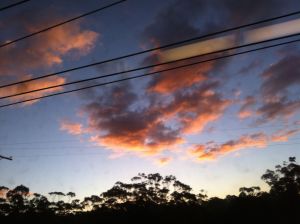
I’ve recently been floating around a new concept that may very well tie all of my creative work together, and in the scheme of things makes a whole lot of sense in relation to the music I’ve been trying to create, the ‘spectral’ quality that I’ve been seeking
The concept of liminality (drawing from Greek work limin, meaning ‘a threshold’) describes a state of being that is between things, inter-medial, in transition, suspended… and in many respects, this is very good fit for the quality I’ve been looking for. Although the term itself is drawn from anthropology and refers to a transitional state in rituals and rites of passage, between casting off a previous identity and adopting a new one, it has applications in many areas, and for myself this applies especially to the time-based aspects of my work. Whereas I had been preoccupied with the methods used to produce the ‘spectral’ quality I was observing, namely the use of timbre, drone, repetition, quartal harmony approaches etc., what I’d been after all along was a suspension of time in music; being in ‘a moment’ so speak, and trying to make that last as long as feasibly possible. Liminality perhaps defines this, as an overarching concept or idea, which up until now I didn’t have a name for. It makes a lot of sense – quartal harmony is really an in-between approach to composition, in comparison to more conventional tertial harmony approaches, as I’d been searching for an suspended quality in harmony that didn’t feel a need for resolution. Emphasising timbral aspects in composition over harmonising a melody is perhaps another example of liminality, looking at composition with a more ‘vertical’ approach to sound. Using repetition to focus upon the phenomena of sound (a phenomenological approach) I believe also emphasises this quality, and my recent use of polyrhythms to further disrupt a sense of absolute metre in a piece also contributes to a sense of being ‘in-between’, the potential in what may be, a kind of ‘becoming’… the moment between sleep and waking, the nexus between day and night (twilight), the midpoint between conscious thought and daydreaming…. well, that’s pretty much what I’ve been after all along, really.
 What I’ve created thus far has been, in a way, meditative, but not in the conventional sense that ‘meditation music’ usually is, replete with washy synthesisers, distant vocals and pan pipes. I’ve avoided using synthesisers up until this point, which I suspect is something to do with not using ‘real’ instruments, it feels a little like cheating. But really, I’ve been disguising the nature of the instruments or sounds that I’ve been using all along, so in this sense I seem to be striving for a state of unreality. I’ve been unsure up until this point whether to take this all into the realm of the fantastic or surreal, which is what synths seem to do, but working with natural sounds and timbres and seeing what I can do to enhance, or perhaps extend, the normal listening experience of these instruments seems to be my primary working method, so…? Perhaps this project is more about creating a mood, or ambience, or perhaps a state of listening – a place in-between the real and the unreal aspects of sound, taking something that you already recognise and then bending or twisting it, taking it into another realm or world. It seem there’s no point in starting with a sound that’s fantastic to begin with, because there’s no semiotic meaning or reference one can ascribe to it – it appears one has to take an existing, recognisable sound first, establish its significance and then take it on a journey elsewhere. Which is what I seem to have been doing, perhaps inadvertently…
What I’ve created thus far has been, in a way, meditative, but not in the conventional sense that ‘meditation music’ usually is, replete with washy synthesisers, distant vocals and pan pipes. I’ve avoided using synthesisers up until this point, which I suspect is something to do with not using ‘real’ instruments, it feels a little like cheating. But really, I’ve been disguising the nature of the instruments or sounds that I’ve been using all along, so in this sense I seem to be striving for a state of unreality. I’ve been unsure up until this point whether to take this all into the realm of the fantastic or surreal, which is what synths seem to do, but working with natural sounds and timbres and seeing what I can do to enhance, or perhaps extend, the normal listening experience of these instruments seems to be my primary working method, so…? Perhaps this project is more about creating a mood, or ambience, or perhaps a state of listening – a place in-between the real and the unreal aspects of sound, taking something that you already recognise and then bending or twisting it, taking it into another realm or world. It seem there’s no point in starting with a sound that’s fantastic to begin with, because there’s no semiotic meaning or reference one can ascribe to it – it appears one has to take an existing, recognisable sound first, establish its significance and then take it on a journey elsewhere. Which is what I seem to have been doing, perhaps inadvertently…
I believe this is it, the quality I’ve been looking for – it’s the nexus, the liminal state between the everyday and the other… and I suspect it’s something I’ve been looking for in music for quite a long time.

Pingback: The phenomenological aspect of sound and vision | Adventures In Sound & Vision
Pingback: Affect in music and imagery | Adventures In Sound & Vision